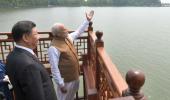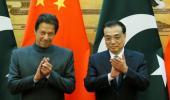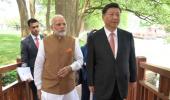'The Chinese mindset and approach to India is far different from that in Pakistan.'
'This reality makes it possible for us to follow an engagement policy with one, while militating against engagement with the other.'
Ambassador Gautam Bambawale -- who served as India's high commissioner in Pakistan and ambassador to China -- delivered the Air Marshal Y V Malse Memorial Lecture 2019 in Pune on July 23, 2019.
The ambassador divided the lecture into three parts. First, he spoke on Pakistan and India's relations with that country, which you can read below.
In this concluding segment of his lecture, Ambassador Bambawale focuses on China and how India can tackle the increasingly close axis between both these neighbours of ours.
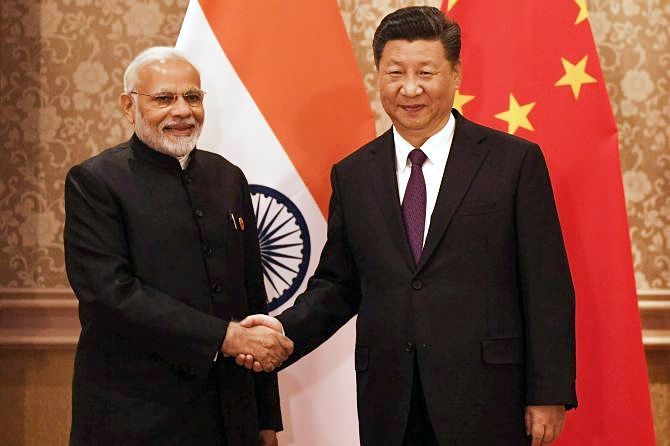
Since India's economic restructuring policy of 1991 went into effect, India has grown admirably at roughly 6-7 per cent per annum.
In the ten-year period ending 2015 we have been able to raise almost 300 million of our people above the poverty line. This is no mean feat.
However, over the last 40 years our northern neighbour China has grown even faster and has become the second largest economy in the world and simultaneously has almost eradicated all poverty in their country.
China's economic rise has been spectacular even as she focusses her attention on building newer infrastructure, becoming the manufacturing hub of the world and now concentrating her energies on transforming to an innovation based economy.
Being a centrally run and driven system, China has also spent a lot of enterprise on building its military strength.
Given the fact that she is a neighbour with whom we have an unresolved boundary problem, the question arises how do we deal with China?
Several governments of India under different prime ministers from different political parties have followed the policy of engaging China even as we discuss the problematic issues between us.
This is the sensible, pragmatic, approach to follow.
Can we leverage China's development for our own growth even as we talk to them on the difficult issues?
The answer in my view is -- yes we can!
What is the opinion of India of an average Chinese person in the street?
First, the average Chinese person remembers that both India and China are ancient civilisations with histories stretching back millennia.
Also, Buddhism traveled from India to China and made a deep impact in that country which reverberates even today.
So, in the past India and China not merely exchanged goods and services, but there was also an exchange of ideas and cultures.
Fast forwarding to the current era, most Chinese think that India is an IT or a software superpower.
While serving in China, I used to be asked this question repeatedly.
How is India so good at software? How come you export more software than even China? What accounts for this success?
In reply, I would state that writing software requires a certain degree of indiscipline and out of the box thinking which Indians are good at, while Chinese people are far too disciplined.
This would always produce a nervous laugh from my Chinese interlocutors.
Finally, some of the ordinary Chinese people we met would accept that there are some outstanding political issues between our countries.
The larger point I would like to make here is that the Chinese mindset and approach to India is far different from that in Pakistan.
This reality makes it possible for us to follow an engagement policy with one, while militating against engagement with the other.
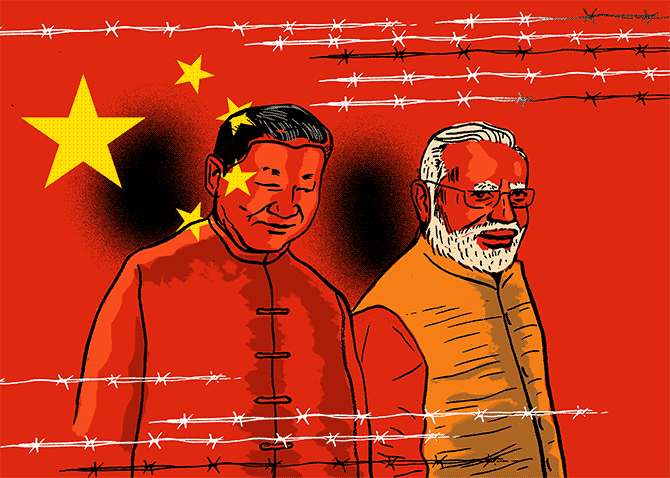
What is lacking between India and China is trust and understanding especially between our Governments.
A policy of interaction, cooperation and engagement is helping to re-build some of the trust which is so important between nations and peoples.
Therefore, I have argued for expanding Chinese tourism into India by having more direct flights between cities of the two nations, by expanding our marketing efforts in China of Incredible India.
There will be many takers for our Buddhist circuit as well as for our hill stations, sea side resorts and cultural centres.
With rising incomes, China has been sending out almost 150 million tourists each year and even if we can capture one per cent of this market we shall not merely achieve all our tourism related targets but also ensure jobs for many of our young people.
I am also of the opinion that India is well placed to capture a sizeable part of the Chinese student community who studies abroad.
All of us are aware of the huge numbers of Chinese students at US universities.
I am confident that if we spend time, effort and money in marketing Indian undergraduate education in China, and making them the value proposition that they should come to India for their undergraduate education and also learn excellent English at this stage of their careers with the strong possibility of going to the US or Britain or Australia or Canada for their post graduate degrees, we shall be able to attract very serious volumes of Chinese undergrad students.
A few universities in south India like VIT and SRM have already discovered this reality.
I am trying to convince universities in Pune to invest a little time and effort in attracting Chinese students to our city.
I am very confident that we shall discover that larger than expected numbers of Chinese students will come to India.

A third area of great potential in India -- China exchange is the sale of Hindi, Bollywood films in China.
Recently, the success of Dangal in China has shocked as well as awakened Bollywood.
Did you know that Dangal made twice as much money in China than it did in India? This is the reality of the Chinese market and we must awaken to the fact that China should not merely be a place to source our materials but also provides a huge market for our goods and services.
The Indian film Hindi Medium also did extremely well in China.
I asked several young Chinese persons why they were happy to pay and watch a Dangal or a Hindi Medium.
The reply I received was eye opening. These youngsters told me that they would prefer to watch socially relevant films dealing with the status of women like Dangal, or the craze for an English medium education like Hindi Medium to the mindless action and thriller movies which Hollywood was constantly producing.
So, there is huge scope for Bollywood to export their good movies to China.
I have so far dwelt at length on exchanges between the people of India and China because greater people-to-people contact and understanding is the bedrock on which State-to-State relations are eventually based.
Greater flows of tourists, students and movies between India and China will greatly enhance our understanding and comprehension of each other which in turn will stand India-China relations in good stead.
I also want to highlight that the exchanges between India and China need not be a one-way street.
There are many things which India can sell in the huge Chinese market.
Turning to trade and investment between India and China, the huge trade imbalance India experiences with China is a problem.
Trade of this nature is not sustainable and we have been telling the Chinese this.
The problem is that we export mainly primary products to China while we import a whole range of finished goods including machinery, mobile handsets, electronics and other value added items.
The two areas where Indian exports to China could increase is pharmaceuticals and computer software, but we face huge non-tariff barriers on these products in China.
One way to offset the trade deficit is to attract Chinese greenfield investment into India.
So far this is taking place only slowly. In fact, Chinese industry is looking to invest in other countries and large numbers of Chinese companies are setting up shop in Vietnam and Indonesia.
We can only succeed in attracting them to India if the ease of doing business enhances exponentially.
There are some other technologies available in China which India can look at seriously.
While China's high speed railway or HSR is becoming well known in India, she also ensures that all trains run at speeds of roughly 200 kms per hour.
If we are able to learn these techniques including the rail tracks necessary for such speed we shall ensure that all Indian passengers reach their destinations faster.
Furthermore, Chinese railway stations are akin to airports with lots of shops and other amenities available.
We too are modernising our railway stations and surely we can seek Chinese assistance in this matter.
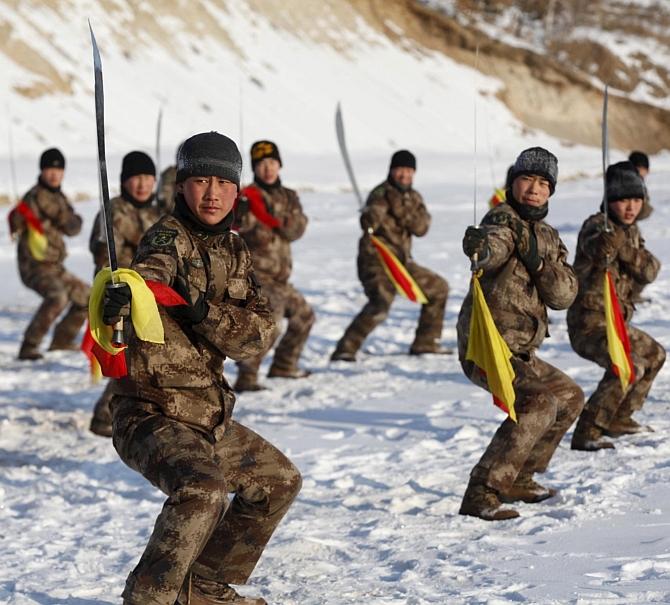
Let me turn to the boundary question between India and China.
While we continue to discuss the boundary issue with China, and are now in the second stage of a three stage process, we are still some way off from reaching a boundary resolution.
Both countries have agreed that in the meanwhile, we shall ensure that peace and tranquility prevails on our borders.
For this purpose we have established a number of channels of communication between border commanders including hotlines, flag meetings, exchanges on special occasions as well as links between the headquarters of the two countries.
Despite all these channels of communication, because we have no common perception of the Line of Actual Control or LAC between us, there some times are incidents where our troops come into close proximity situations.
These are also called faceoffs. Three recent incidents come to mind. The first was in 2013 at Depsang in Ladakh. The second was in 2014 at Chumar also in Ladakh. The third and most serious of these faceoffs was at Doklam in 2017.
Such faceoffs occur because there is no agreed line -- neither a boundary nor a Line of Actual Control -- between India and China and because China continues to build roads in its border areas some times transgressing our perception of the LAC.
We too are building a lot of border roads and perhaps we too may sometimes go into territory which China perceives as its own.
This is natural when there is no agreed line between States and hence the importance of either clarifying the LAC or delimiting a boundary line.
However, as many of the military and defence experts in the audience will understand and agree, our media does not do anyone favours by its chest thumping over such incidents.
This merely alarms our public especially since understanding the realities of our Himalayan borders is not an easy task.
At the same time, as a nation, we cannot lower our guard and we must be ready to militarily defend ourselves.
Currently, India spends about 1.3% of our GDP on defence.
I would strongly support an increase in our defence spending up to about 2% of GDP.
That would make us prepared for any eventuality including what is described as a two front war with the strengthening China-Pakistan axis.
We are all aware that we are short of some critical equipment and stores.
For example the Indian Air Force would like to have more squadrons of air power to keep India safe.
The same is the case with the army as well as the navy. Spending about 2% of our GDP would enable us to be prepared.
At the same time, our armed forces are well aware of the reform being undertaken by China in its military establishment with the creation of new theatre commands which are comprised of joint tri-service personnel.
Jointness of operations is something which the Indian armed forces will have to prepare for and undertake very soon.
Such reform will have to come from within our armed services rather than being forced from outside.
The writing is on the wall, and we better change quickly rather than due to some emergency.
WATCH: Stroll and a boat ride for Modi in Wuhan
Let me spend a little while discussing the Wuhan informal summit between the leaders of India and China which took place in April 2018.
The reason both sides were keen to have an informal summit is that it would give the leaders -- PM Modi and President Xi -- a lot of time together to talk about the important issues between us.
This is exactly what happened, with the leaders having discussions with each other for about 8 or 9 hours, which is much longer than if there had been a formal visit by Prime Minister Modi to China.
The success of this format can be seen from the fact that we are now already planning for a second informal summit here in India this October.
The success of the last informal summit can be seen from the relative calm which has prevailed in the India-China border areas over this past year.
This has been the result of directives from the two leaders to their respective military authorities.
So there have been direct benefits arising from the informal summit.
Yet another success has been the rise in India's exports to China and the reduction in our trade deficit with that country.
This too can be traced back directly to the discussions between our leaders.
Therefore, I believe that our policy of engagement with China has been beneficial to India and has indeed served our national interest.

Let me spend a bit of time on the close axis between China and Pakistan.
First, let me talk a wee bit on the China Pakistan Economic Corridor or CPEC.
The fact that China is willing to invest over $60 billion in Pakistan shows their commitment to Pakistan.
However, an economic corridor consists of a transport corridor and then on either side of such a transport corridor are economic zones or industrial parks which provide the employment and manufacturing capacity which will make a difference to the Pakistan economy.
Given Chinese prowess in building roads and railways, I am certain that the transport corridor will come up successfully.
What is uncertain is who or which companies will invest in the industrial zones along the corridor.
As you are aware there is very little investment being made in Pakistan either by their own firms or by foreign ones.
In my opinion, this will always be a question mark over the CPEC.
China has emerged as Pakistan's most important arms supplier as well as its closest international ally.
There is little doubt that this presents a challenge for India.
However, our military authorities have already prepared and planned for a two-front situation.
While it will prove difficult to manage, I am confident that India can defend itself even if such a situation were to force itself on us.
Diplomatically, we have tried to get each of those countries to see our viewpoint but as all of you can appreciate this will prove to be quite a difficulttask.
Even then, our success in getting China to drop its hold on the process to designate Masood Azhar as an international terrorist shows that it can be done with perseverance, clarity of thought and single mindedness of purpose.
Finally, let me clearly state that India's ability to combat this axis will depend entirely on what we do internally within our nation.
India's economy has to grow and we have to develop along the trend line that we are on.
An annual average GDP growth of 8 per cent per annum is essential if we are to become a 5 trillion dollar economy by 2025.
Continued growth beyond that figure is also key to our ability to tackle international issues and raise our standing in the international community.
So, eventually how we tackle our own domestic issues will be very, very important to our international standing and worth.
Expanding India's comprehensive national power through our own efforts will be fundamentally important.
I for one am confident and certain that we as a society are capable of staying this course that we are on. Therefore, to me, India's future looks bright.

